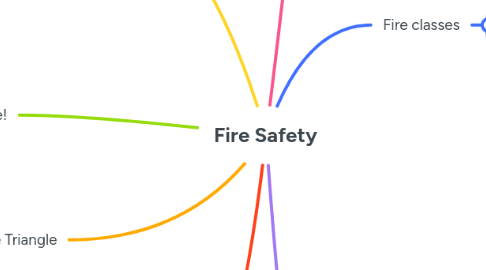
1. Fire classes
1.1. Class A
1.1.1. Dry combustibles
1.1.1.1. paper
1.1.1.2. wood
1.1.1.3. garbage
1.1.1.4. cloth, clothing
1.1.1.5. Ash
1.1.1.6. Non-metal combustibles
1.1.2. Class A or A,B,C extinguisher
1.2. Class B
1.2.1. Flammable liquids
1.2.1.1. Barrel
1.2.1.2. Gas
1.2.1.3. Oil
1.2.1.4. Grease
1.2.1.5. acetone
1.2.1.6. Non-metal in liquid state
1.2.2. Class B or A,B,C
1.2.2.1. Don't use type A extinguisher
1.3. Class C
1.3.1. Electrical
1.3.1.1. Circuit
1.3.1.2. Energized equipment
1.3.2. Class C or A,B,C
1.4. Class D
1.4.1. Exotic Metals
1.4.1.1. Potassium
1.4.1.2. sodium
1.4.1.3. Magnesium
1.4.1.4. Aluminum
1.4.2. Use Dry chemical Extinguisher
2. What NOT to do if there is a fire!
2.1. Don't engage in heroics if you...
2.1.1. don't know what is burning
2.1.2. Fire is spreading
2.1.3. don't have the equipment
2.1.4. your instincts tell you not
2.1.5. you might intake toxic smoke
3. What to do if there is a fire?
3.1. Help others first
3.1.1. If buddy has hot tar of water hug him to keep him on the roof
3.1.2. Get water
3.2. If fire is to big call 911
3.3. Grab proper Class extinguisher
3.4. Make sure you have a safe escape route
4. Fire Triangle
4.1. Heat
4.2. Oxygen
4.3. Fuel
5. Purpose of a fire extinguisher
5.1. Removes components of the fire triangle
5.2. DON'T USE on big fires
5.3. Have one for every torch
6. Fire extinguisher use
6.1. P.A.S.S
6.1.1. Pull the pin
6.1.2. Aim the nozzle
6.1.3. Squeeze the handle
6.1.4. Spread the butter (Sweep)
6.2. Make sure you have a fully charged extinguisher
7. Kettle Fires
7.1. How to put out a fire
7.1.1. Cut fuel source
7.1.1.1. close lid
7.1.1.2. cut fuel source
7.1.1.3. Class B fire Extinguisher
